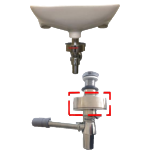Our Product
The Drain Clean System
Invented and designed in Denmark, with a documented effect. It consists of a device installed on sink drainpipes that removes and prevent bacteria from developing. The device consists of two parts. A steel mount which is mounted on any sink drainpipe above the trap, and a UV-C lamp which ensures that all particles moving through the steel mount are directly exposed to UV-C light which burns the DNA/RNA of bacteria and biofilm. The UV-C lamp has a lifetime of 9 000 hours.

Documented and tested by

Industry Focused Products
Effectively removing all types of bacteria
Biofilm
Health Hazards: Biofilms are colonies of bacteria stuck to surfaces and are difficult to combat. They can harbor harmful pathogens, making infections more difficult to treat as the biofilm protects bacteria from antibiotics and the immune system.
Importance of Removal: Eliminating biofilms reduces the risk of persistent and chronic infections.
Hazards of Inaction: Failure to remove biofilms can lead to chronic infections, antibiotic resistance, and contamination of water systems and medical devices.
Salmonella
Health Hazards: Salmonella is a bacterium that causes salmonellosis, characterized by diarrhea, fever, and abdominal cramps.
Importance of Removal: Removing Salmonella prevents foodborne illnesses and outbreaks.
Hazards of Inaction: Not addressing Salmonella contamination can lead to severe dehydration, hospitalization, and even death, particularly in vulnerable populations such as the elderly, infants, and immunocompromised individuals.
Campylobacter
Health Hazards: Campylobacter causes campylobacteriosis, leading to symptoms such as diarrhea, fever, and abdominal pain. In severe cases, it can lead to Guillain-Barré syndrome, a serious autoimmune condition.
Importance of Removal: Ensuring water and food are free from Campylobacter reduces the incidence of foodborne illness.
Hazards of Inaction: Failure to control Campylobacter can result in widespread foodborne illness outbreaks and long-term health complications.
Escherichia Coli
Health Hazards: Some strains of E. coli, particularly E. coli O157, can cause severe foodborne illness, leading to diarrhea, urinary tract infections, respiratory illness, and pneumonia.
Importance of Removal: Preventing E. coli contamination is crucial to avoid severe gastrointestinal infections and possible kidney failure.
Hazards of Inaction: Neglecting E. coli contamination can lead to serious outbreaks, significant public health crises, and potential fatalities.
Staphylococcus
Health Hazards: Staphylococcus bacteria, including MRSA (Methicillin-resistant Staphylococcus aureus), can cause skin infections, pneumonia, and bloodstream infections.
Importance of Removal: Preventing Staphylococcus contamination reduces the risk of severe infections, particularly in healthcare settings.
Hazards of Inaction: Ignoring Staphylococcus can lead to widespread infections, increased healthcare costs, and higher mortality rates due to antibiotic-resistant strains.
Viruses
Health Hazards: Various viruses, including norovirus and hepatitis A, can cause gastrointestinal and liver infections, leading to symptoms like vomiting, diarrhea, and jaundice.
Importance of Removal: Eliminating viruses from environments, particularly food and water sources, prevents outbreaks and spread of viral infections.
Hazards of Inaction: Allowing viral contamination can result in large-scale outbreaks, severe illness, and economic losses due to healthcare costs and lost productivity.
Mould
Health Hazards: Mould can cause respiratory problems, allergic reactions, and aggravate asthma. Certain types of mould produce mycotoxins, which can be harmful when inhaled or ingested.
Importance of Removal: Removing mould prevents respiratory issues and allergic reactions, improving indoor air quality.
Hazards of Inaction: Failure to address mould growth can lead to chronic respiratory issues, structural damage to buildings, and health hazards from mycotoxin exposure.
Pseudomonas aeruginosa
Health Hazards: P. aeruginosa is an opportunistic pathogen that can cause infections in the blood, lungs, and other parts of the body, particularly in immunocompromised individuals.
Importance of Removal: Preventing P. aeruginosa contamination reduces the risk of severe, difficult-to-treat infections.
Hazards of Inaction: Not controlling P. aeruginosa can result in persistent infections, increased antibiotic resistance, and higher morbidity and mortality rates in healthcare settings.